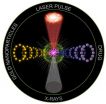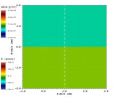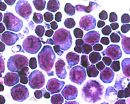(Press-News.org) HOUSTON -- (June 1, 2014) -- The first preclinical study of a new Rice University-developed anti-cancer technology found that a novel combination of existing clinical treatments can instantaneously detect and kill only cancer cells -- often by blowing them apart -- without harming surrounding normal organs. The research, which is available online this week Nature Medicine, reports that Rice's "quadrapeutics" technology was 17 times more efficient than conventional chemoradiation therapy against aggressive, drug-resistant head and neck tumors.
The work was conducted by researchers from Rice, the University of Texas MD Anderson Cancer Center and Northeastern University.
"We address aggressive cancers that cannot be efficiently and safely treated today," said Rice scientist Dmitri Lapotko, the study's lead investigator. "Surgeons often cannot fully remove tumors that are intertwined with important organs. Chemotherapy and radiation are commonly used to treat the residual portions of these tumors, but some tumors become resistant to chemoradiation. Quadrapeutics steps up when standard treatments fail. At the same time, quadrapeutics complements current approaches instead of replacing them."
Lapotko said quadrapeutics differs from other developmental cancer treatments in that it radically amplifies the intracellular effect of drugs and radiation only in cancer cells. The quadrapeutic effects are achieved by mechanical events -- tiny, remotely triggered nano-explosions called "plasmonic nanobubbles." Plasmonic nanobubbles are non-stationary vapors that expand and burst inside cancer cells in nanoseconds in response to a short, low-energy laser pulse. Plasmonic nanobubbles act as a "mechanical drug" against cancer cells that cannot be surgically removed and are otherwise resistant to radiation and chemotherapy.
In prior studies, Lapotko showed he could use plasmonic nanobubbles alone to literally blow cells apart. In quadrapeutics, his team is using them to detect and kill cancer cells in three ways. In cancer cells that survive the initial explosions, the bursting nanobubbles greatly magnify the local doses of both chemotherapy drugs and radiation. All three effects -- mechanical cell destruction, intracellular drug ejection and radiation amplification -- occur only in cancer cells and do not harm vital healthy cells nearby.
To administer quadrapeutics, the team uses four clinically approved components: chemotherapy drugs, radiation, near-infrared laser pulses of low energy and colloidal gold.
"Quadrapeutics shifts the therapeutic paradigm for cancer from materials -- drugs or nanoparticles -- to mechanical events that are triggered on demand only inside cancer cells," Lapotko said. "Another strategic innovation is in complementing current macrotherapies with microtreatment. We literally bring surgery, chemotherapies and radiation therapies inside cancer cells."
The first component of quadrapeutics is a low dose of a clinically validated chemotherapy drug. The team tested two: doxorubicin and paclitaxel. In each case, the scientists used encapsulated versions of the drug that were tagged with antibodies designed to target cancer cells. Thanks to the magnifying effect of the plasmonic nanobubbles, the intracellular dose -- the amount of the drug that is active inside cancer cells -- is very high even when the patient receives only a few percent of the typical clinical dose.
The second component is an injectable solution of nontoxic gold colloids, tiny spheres of gold that are thousands of times smaller than a living cell. Quadrapeutics represents a new use of colloidal gold, which has been used for decades in the clinical treatment of arthritis. In quadrapeutics, the gold colloids are tagged with cancer-specific clinically approved antibodies that cause them to accumulate and cluster together inside cancer cells. These gold "nanoclusters" do nothing until activated by a laser pulse or radiation.
The third quadrapeutic component is a short near-infrared laser pulse that uses 1 million times less energy that a typical surgical laser. A standard endoscope delivers the laser pulse to the tumor, where the gold nanoclusters convert the laser energy into plasmonic nanobubbles.
The fourth component is a single, low dose of radiation. The gold nanoclusters amplify the deadly effects of radiation only inside cancer cells, even when the overall dose to the patient is just a few percent of the typical clinical dose.
"What kills the most-resistant cancer cells is the intracellular synergy of these components and the events we trigger in cells," Lapotko said. "This synergy showed a 100-fold amplification of the therapeutic strength of standard chemoradiation in experiments on cancer cell cultures."
In the Nature Medicine study, the team tested quadrapeutics against head and neck squamous cell carcinoma (HNSCC), an aggressive and lethal form of cancer that had grown resistant to both chemotherapy drugs and radiation. Quadrapeutics proved so deadly against HNSCC tumors that a single treatment using just 3 percent of the typical drug dose and 6 percent of the typical radiation dose effectively eliminated tumors in mice within one week of the administration of quadrapeutics.
Lapotko, a faculty fellow in biochemistry and cell biology and in physics and astronomy, said he is working with colleagues at MD Anderson and Northeastern to move as rapidly as possible toward prototyping and a human clinical trial. In clinical applications, quadrapeutics will be applied as either a stand-alone or intra-operative procedure using standard endoscopes and other clinical equipment and encapsulated drugs such as Doxil or Lipoplatin. Though the current study focused on head and neck tumors, Lapotko said quadrapeutics is a universal technology that can be applied for local treatment of various solid tumors, including other hard-to-treat types of brain, lung and prostate cancer. He said it might also prove especially useful for treating children due to its safety.
"The combination of aggressiveness and drug and radiation resistance is particularly problematic in tumors that cannot be fully resected, and new efficient solutions are needed," said Dr. Ehab Hanna, a surgeon and vice chair of the Department of Head and Neck Surgery at MD Anderson, who was not involved with the testing or development of quadrapeutics. "Technologies that can merge and amplify the effects of surgery, drugs and radiation at the cellular level are ideal, and the preclinical results for quadrapeutics make it a promising candidate for clinical translation."
INFORMATION:
Study co-authors included Rice research scientist Ekaterina Lukianova-Hleb, MD Anderson researchers Xiangwei Wu and Xiaoyang Ren and Northeastern researchers Vladimir Torchilin and Rupa Sawant.
The research was supported by the National Institutes of Health, the National Science Foundation and the Virginia and L.E. Simmons Family Foundation.
VIDEO is available at:
http://youtu.be/_pgH6YMby3M
High-resolution IMAGES are available for download at:
http://news.rice.edu/wp-content/uploads/2014/05/0606_QUAD-diagram-lg.jpg
CAPTION: The first preclinical study of the anti-cancer technology "quadrapeutics" found it to be 17 times more efficient than conventional chemoradiation therapy against aggressive, drug-resistant head and neck tumors.
CREDIT: D. Lapotko/Rice University
http://news.rice.edu/wp-content/uploads/2012/04/0406_NANOBUBBLES-1.jpg
CAPTION: Dmitri Lapotko
CREDIT: Jeff Fitlow/Rice University
http://news.rice.edu/wp-content/uploads/2014/05/0606_QUAD-Hleb-lg.jpg
CAPTION: Ekaterina Lukianova-Hleb
CREDIT: Jeff Fitlow/Rice University
A copy of the Nature Medicine paper is available at:
http://dx.doi.org/10.1038/nm.3484
This release can be found online at news.rice.edu.
Follow Rice News and Media Relations via Twitter @RiceUNews.
Located on a 300-acre forested campus in Houston, Rice University is consistently ranked among the nation's top 20 universities by U.S. News & World Report. Rice has highly respected schools of Architecture, Business, Continuing Studies, Engineering, Humanities, Music, Natural Sciences and Social Sciences and is home to the Baker Institute for Public Policy. With 3,920 undergraduates and 2,567 graduate students, Rice's undergraduate student-to-faculty ratio is 6.3-to-1. Its residential college system builds close-knit communities and lifelong friendships, just one reason why Rice has been ranked No. 1 for best quality of life multiple times by the Princeton Review and No. 2 for "best value" among private universities by Kiplinger's Personal Finance.
'Quadrapeutics' works in preclinical study of hard-to-treat tumors
Animal tests show Rice-developed technology effective against aggressive cancer
2014-06-01
ELSE PRESS RELEASES FROM THIS DATE:
CSIC develops a software able to identify and track an specific individual within a group
2014-06-01
Researchers from the Spanish National Research Council (CSIC) have developed a software based on the discovery of some algorithms that enable the identification of each individual, therefore allowing their tracking within the group. Thus, the door opens to the quantitative study of the rules of social interaction for many species. The work has been published in the Nature Methods journal.
Animals that move in groups make decisions considering what other members of their community do. To find out the rules of these interactions, researchers record monitoring videos through ...
Graphene's multi-colored butterflies
2014-06-01
Writing in Nature Physics, a large international team led by Dr Artem Mishchenko and Sir Andre Geim from The University of Manchester shows that the electronic properties of graphene change dramatically if graphene is placed on top of boron nitride, also known as 'white graphite'.
One of the major challenges for using graphene in electronics applications is the absence of a band gap, which basically means that graphene's electrical conductivity cannot be switched off completely. Whatever researchers tried to do with the material so far, it remained highly electrically ...
Paired enzyme action in yeast reveals backup system for DNA repair
2014-06-01
The combined action of two enzymes, Srs2 and Exo1, prevents and repairs common genetic mutations in growing yeast cells, according to a new study led by scientists at NYU Langone Medical Center.
Because such mechanisms are generally conserved throughout evolution, at least in part, researchers say the findings suggest that a similar DNA repair kit may exist in humans and could serve as a target for controlling some cancers and treating a rare, enzyme-linked genetic disorder called Aicardi-Goutieres syndrome. The syndrome, an often fatal neurological condition, is found ...
Pitt team first to detect exciton in metal
2014-06-01
PITTSBURGH—University of Pittsburgh researchers have become the first to detect a fundamental particle of light-matter interaction in metals, the exciton. The team will publish its work online June 1 in Nature Physics.
Mankind has used reflection of light from a metal mirror on a daily basis for millennia, but the quantum mechanical magic behind this familiar phenomenon is only now being uncovered.
Physicists describe physical phenomena in terms of interactions between fields and particles, says lead author Hrvoje Petek, Pitt's Richard King Mellon Professor in the Department ...
Subtle change in DNA, protein levels determines blond or brunette tresses, study finds
2014-06-01
STANFORD, Calif. — A molecule critical to stem cell function plays a major role in determining human hair color, according to a study from the Stanford University School of Medicine.
The study describes for the first time the molecular basis for one of our most noticeable traits. It also outlines how tiny DNA changes can reverberate through our genome in ways that may affect evolution, migration and even human history.
"We've been trying to track down the genetic and molecular basis of naturally occurring traits — such as hair and skin pigmentation — in fish and humans ...
International collaboration replicates amplification of cosmic magnetic fields
2014-06-01
VIDEO:
This video simulation shows how a laser that illuminates a small carbon rod launches a complex flow, consisting of supersonic shocks and turbulent flow. When the grid is present, turbulence...
Click here for more information.
Astrophysicists have established that cosmic turbulence could have amplified magnetic fields to the strengths observed in interstellar space.
"Magnetic fields are ubiquitous in the universe," said Don Lamb, the Robert A. Millikan Distinguished ...
Researchers discover hormone that controls supply of iron in red blood cell production
2014-06-01
A UCLA research team has discovered a new hormone called erythroferrone, which regulates the iron supply needed for red blood-cell production.
Iron is an essential functional component of hemoglobin, the molecule that transports oxygen throughout the body. Using a mouse model, researchers found that erythroferrone is made by red blood-cell progenitors in the bone marrow in order to match iron supply with the demands of red blood-cell production. Erythroferrone is greatly increased when red blood-cell production is stimulated, such as after bleeding or in response to anemia.
The ...
Leptin also influences brain cells that control appetite, Yale researchers find
2014-06-01
Twenty years after the hormone leptin was found to regulate metabolism, appetite, and weight through brain cells called neurons, Yale School of Medicine researchers have found that the hormone also acts on other types of cells to control appetite.
Published in the June 1 issue of Nature Neuroscience, the findings could lead to development of treatments for metabolic disorders such as obesity and diabetes.
"Up until now, the scientific community thought that leptin acts exclusively in neurons to modulate behavior and body weight," said senior author Tamas Horvath, the ...
Mayo Clinic: Ovarian cancer subtypes may predict response to bevacizumab
2014-06-01
CHICAGO — Molecular sequencing could identify ovarian cancer patients who are most likely to benefit from treatment with bevacizumab (Avastin), a Mayo Clinic-led study has found. Results of the research were presented today at the 2014 American Society of Clinical Oncology Annual Meeting.
The addition of bevacizumab to standard therapy extended progression-free survival more for ovarian cancer patients with molecular subtypes labeled as "proliferative" or "mesenchymal" compared to those with subtypes labeled as "immunoreactive" or "differentiated," says Sean Dowdy, M.D., ...
Oncologists: How to talk with your pathologist about cancer molecular testing
2014-06-01
As targeted therapies become more available, increasing opportunity exists to match treatments to the genetics of a specific cancer. But in order to make this match, oncologists have to know these genetics. This requires molecular testing of patient samples. An education session presented today at the American Society for Clinical Oncology (ASCO) Annual Meeting 2014 details the challenges in this process and makes recommendations that oncologists can use to ensure their patients' samples are properly tested, helping to pair patients with the best possible treatments.
"The ...
LAST 30 PRESS RELEASES:
What causes some people’s gut microbes to produce high alcohol levels?
Global study reveals widespread burning of plastic for heating and cooking
MIT study shows pills that communicate from the stomach could improve medication adherence
Searching for the centromere: diversity in pathways key for cell division
Behind nature’s blueprints
Researchers search for why some people’s gut microbes produce high alcohol levels
Researchers find promising new way to boost the immune response to cancer
Coffee as a staining agent substitute in electron microscopy
Revealing the diversity of olfactory receptors in hagfish and its implications for early vertebrate evolution
Development of an ultrasonic sensor capable of cuffless, non-invasive blood pressure measurement
Longer treatment with medications for opioid use disorder is associated with greater probability of survival
Strategy over morality can help conservation campaigns reduce ivory demand, research shows
Rising temperatures reshape microbial carbon cycling during animal carcass decomposition in water
Achieving ultra-low-power explosive jumps via locust bio-hybrid muscle actuators
Plant-derived phenolic acids revive the power of tetracycline against drug-resistant bacteria
Cooperation: A costly affair in bacterial social behaviour?
Viruses in wastewater: Silent drivers of pollution removal and antibiotic resistance
Sub-iethal water disinfection may accelerate the spread of antibiotic resistance
Three in four new Australian moms struggle with body image
Post-stroke injection protects the brain in preclinical study
Cardiovascular risk score predicts multiple eye diseases
Health: estimated one in ten British adults used or interested in GLP-1 medications for weight loss
Exercise to treat depression yields similar results to therapy
Whooping cough vaccination for pregnant women strengthens babies’ immune system
Dramatic decline in new cases of orphanhood in Uganda driven by HIV treatment and prevention programs
Stopping weight loss drugs linked to weight regain and reversal of heart health markers
Higher intake of food preservatives linked to increased cancer risk
Mass General Brigham–developed cholera vaccine completes phase 1 trial
First experimental validation of a “150-year-old chemical common sense” direct visualization of the molecular structural changes in the ultrafast anthracene [4+4] photocycloaddition reaction
Lack of support for people on weight loss drugs leaves them vulnerable to nutritional deficiencies, say experts
[Press-News.org] 'Quadrapeutics' works in preclinical study of hard-to-treat tumorsAnimal tests show Rice-developed technology effective against aggressive cancer



